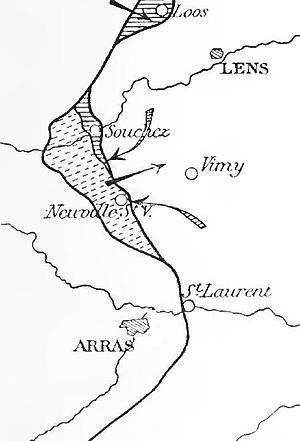Third Battle of Artois
| Third Battle of Artois | |||||||
|---|---|---|---|---|---|---|---|
| Part of the Western Front of the First World War | |||||||
 Franco-British offensive, September 1915 |
|||||||
|
|||||||
| Belligerents | |||||||
|
|
|
||||||
| Commanders and leaders | |||||||
|
|
|
||||||
| Strength | |||||||
|
French Tenth Army 10 divisions British First Army 8 divisions |
6th Army 9 divisions |
||||||
| Casualties and losses | |||||||
|
|
(including 2,000 POW) |
||||||
The Third Battle of Artois (25 September – 4 November 1915), was fought by the French Tenth Army against the German 6th Army on the Western Front of World War I. The battle is also known as the Loos–Artois Offensive and included the big British offensive by the British First Army, known as the Battle of Loos. The offensive, meant to complement the Second Battle of Champagne, was the last attempt of 1915 by the French commander-in-chief Joseph Joffre to exploit an Allied numerical advantage over Germany. Joffre's plan was for simultaneous attacks in Champagne-Ardenne and Artois, to capture the railways at Attigny and Douai, to force a German withdrawal from the Noyon salient.
Joffre's plan was a series of attacks along the Western Front, supported by Italian attacks across the Isonzo River and a British Expeditionary Force (BEF) attack near Loos-en-Gohelle. At first, Field Marshal John French and General Sir Douglas Haig opposed the attack, because of the lie of the land, a lack of heavy artillery, ammunition and reserves. The generals were overruled by the British minister of war, Lord Horatio Kitchener, who ordered French and Haig to conduct the offensive.
The Tenth Army massed seventeen infantry and two cavalry divisions for the offensive, backed by 630 field guns and 420 heavy artillery pieces. The German 6th Army had about thirteen divisions and from 19–13 September, the French fired 1.4 million field gun shells and 250,000 heavy rounds at the German defences. Obsolete 90 mm guns were used to fire another 63,500 shells.
...
Wikipedia
